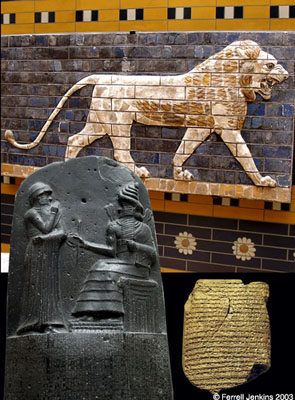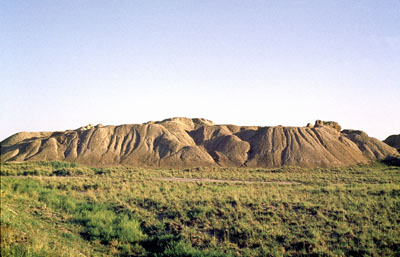Babylon
City of Nebuchadnezzar
By Ferrell JenkinsPublished in Biblical Insights
May, 2003This montage of items from Babylon illustrates the greatness of ancient Babylonia. The winged lion is from the Procession Street of Nebuchadnezzar's Babylon (Istanbul Archaeological Museum). the stele is the top of the Code of Hammurabi (Louvre). The tablet is the Babylonian Chronicle that tells of the capture of Jerusalem by the Babylonians March 16, 597 B.C. (British Museum). The items are not shown in proportion. The tablet is only 3 1/4 inches high. Photos © Ferrell Jenkins 2003.
The site of Babylon is located about 55 miles southwest of Baghdad near Hillah in Iraq. The city was located on the River Euphrates, but is now a few miles east of the river on one of the canals. The rivers of Mesopotamia have frequently changed their course.
The earliest ancient name for Babylon, given in the table of nations, was Babel (Gen. 10:10). Babylon was ruled by Hammurabi, best known for his law code, in the 18th century B.C.
The city reached its peak during the Neo-Babylonian empire (626-539 B.C.). The Bible refers to Babylon as "the beauty of kingdoms, the glory of the Chaldeans' pride" (Isa 13:19).
The greatest king of the Neo-Babylonian empire was Nebuchadnezzar (605-562 B.C.). There is abundant evidence of the activities of his reign. The best collections of artifacts are to be found in the British Museum in London and the Museum of the Near East (part of the Pergamon Museum) in Berlin. In Berlin one may see the reconstructed Procession Street, the Ishtar Gate, and the decorated facade of the Throne Room of Nebuchadnezzar from Babylon.
in 1970. Jeremiah 51:37 provides a wonderful caption:
"And Babylon will become a heap of ruins.The kingdom of Judea had much contact with the Babylonians. Daniel was in the first group of Judean royal youths taken into Babylonian exile in 605 B.C., and was educated in the literature and language of Babylon (Dan 1:1-6). Jerusalem fell to Nebuchadnezzar's army March 15/16, 597 B.C. At that time Jehoiachin and 10,000 captives were taken as prisoners to Babylon (2 Kings 24:8-16). The prophet Ezekiel was among that group of captives. His prophetic call came in the fifth year of his exile by the river Chebar, a tributary of the Euphrates (Ezekiel 1:1-3).
The Judean captives remained in Babylon until the time of the Medes and Persians (Jeremiah 25:11-12). Cyrus, according to a clay cylinder now in the British Museum, allowed captives to return to their home land, build their temples and serve their own gods. This is in harmony with the biblical account in 2 Chronicles 36 and Ezra 1.
Excavations were conducted at Babylon by German archaeologists between 1899 and 1917. Discoveries included the main palace of Nebuchadnezzar, the procession street, some temples, and the Ishtar gate. The most fabulous of the items to be found have been reconstructed in the Museum of the Near East in Berlin. I have been able to visit Babylon only once in 1970.
Photos © Ferrell Jenkins 2003.
The photos may be used by others in teaching, but may not be used commercially or on web sites without permission.

